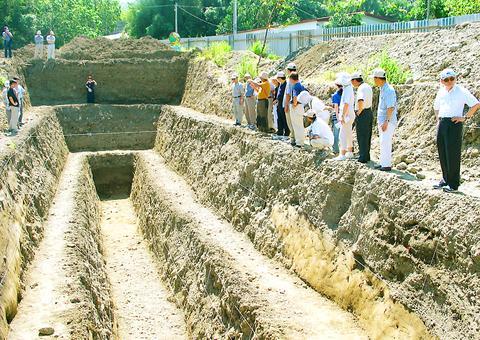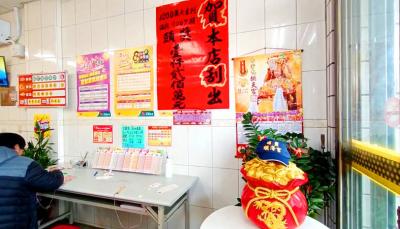Since the 921 Earthquake in 1999, scientists have thrown everything into identifying predictors of the devastating phenomenon, looking beneath the ground and even from space in a bid to improve understanding of the mechanisms responsible.
Standing beside a monitor detecting crust deformations at National Dong Hwa University in Hualien last year, National Central University geophysicist Yen Horng-yuan (
According to Yen, studies of past earthquakes suggest there is an association between the phenomenon of advance crust deformation and the onset of earthquakes.

PHOTO: CHIU YU-TZU, TAIPEI TIMES
"By carrying out continuous monitoring, we can analyze an abundant amount of data to find out where the crust begins to change before the occurrence of an earthquake. This data might be useful for research on predicting quakes," Yen said.
By the end of 2006, another 30 stations will be set up around the country to complete the GPS network, he said.
Taiwan sits atop the junction of the Philippine plate and the much larger Eurasian plate. The former is slowly being forced beneath the latter under the northern stretches of the country. The process, referred to by seismologists as subduction, is also being monitored by local geophysicists.
Since August 1998, Lee Jian-cheng (李建成), an associate research fellow at Academia Sinica's Institute of Earth Sciences, has measured crust change with creepmeters set up at Tapo Elementary School in Taitung County, which lies on the active Chihshang Fault (池上斷層).
Creepmeters measure the displacement between areas located on opposite sides of a fault.
Lee said that research suggests the Philippines and Eurasia plates are converging at a speed of 8cm per year. However, Lee's continuous monitoring of the plate suture zone in the Huatung Valley connecting Hualien and Taitung suggests that the fault has contracted between 15cm and 20cm annually over the past five years.
"We are seeing significant fault activity here. So we will continue to study how the fault interacts with others nearby in the valley," he said.
The 200km-long Chihshang Fault is only one of seven active faults to have been discovered in the Huatung Valley. In 1951, two earthquakes resulting from dramatic fault activity here ruptured the surface and changed its topography all the way from Hualien to Taitung. At some locations, the land was raised by 75cm.
To better understand these faults' behavior, National Taiwan University geosciences professor Chen Wen-shan (
"Faults in this valley are regarded by scientists as the most active in Taiwan. By analyzing layers in the trenches we can study the old earthquakes that they caused, and we might develop ideas on predicting future activity," Chen said.
Prior to the 921 Earthquake, which claimed more than 2,400 lives, most Taiwanese had grown less concerned about the occurrence of a devastating temblor.
But a number of earthquakes of similar destructive force did occur earlier last century. The 7-magnitude Meishan Earthquake in 1906 killed more than 1,250 people in the country's southwest. A 7.4-magnitude earthquake in 1935 centered in the Hsinchu-Miaoli area killed over 3,200 people; a 6.5-magnitude aftershock then killed another 2,700.
In the wake of the 921 Earthquake, which also injured more than 8,700 people and left 100,000 people homeless, the National Science Council boosted funding for earthquake-related research. Seismologists, geologists and physicists have since teamed up on innovative projects in a bid to discover signs of when the next one will strike.
Scientists have for years speculated that electromagnetic phenomena might be connected to seismic activity. Now, local physicists have decided to look to space to gather more clues.
Liu Jann-yenq (
After analyzing data of more than 300 earthquakes in Taiwan between 1994 and last year with magnitudes greater than 5, Liu found that for 70 percent of the quakes, ionospheric electron density fell sharply to around 65 percent of the normal level some time in the five days before the temblor.
Liu said that if the magnitude was 6 or higher, around 80 percent of sampled quakes had the same effect.
"We're only trying to find precursors to earthquakes. It doesn't mean we've already established a theory for a mechanism of earthquake prediction," Liu said.
However, he said, the drop in ionospheric electron density did not correlate entirely with the occurrence of earthquakes because other causes of change in electron density are known to exist.
Chen Chau-huei (陳朝輝), a seismologist at National Chung Cheng University, told the Taipei Times that local resources for seismology research remain limited. He said there were only 30 professionals delving into earthquakes.
"Actually, Taiwan can be a leading focus of seismological research because the environment in which we live is actually a natural museum for earthquakes," Chen said.

Actress Barbie Hsu (徐熙媛) has “returned home” to Taiwan, and there are no plans to hold a funeral for the TV star who died in Japan from influenza- induced pneumonia, her family said in a statement Wednesday night. The statement was released after local media outlets reported that Barbie Hsu’s ashes were brought back Taiwan on board a private jet, which arrived at Taipei Songshan Airport around 3 p.m. on Wednesday. To the reporters waiting at the airport, the statement issued by the family read “(we) appreciate friends working in the media for waiting in the cold weather.” “She has safely returned home.

A Vietnamese migrant worker on Thursday won the NT$12 million (US$383,590) jackpot on a scratch-off lottery ticket she bought from a lottery shop in Changhua County’s Puyan Township (埔鹽), Taiwan Lottery Co said yesterday. The lottery winner, who is in her 30s and married, said she would continue to work in Taiwan and send her winnings to her family in Vietnam to improve their life. More Taiwanese and migrant workers have flocked to the lottery shop on Sec 2 of Jhangshuei Road (彰水路) to share in the luck. The shop owner, surnamed Chen (陳), said that his shop has been open for just

Twenty-four Republican members of the US House of Representatives yesterday introduced a concurrent resolution calling on the US government to abolish the “one China” policy and restore formal diplomatic relations with Taiwan. Led by US representatives Tom Tiffany and Scott Perry, the resolution calls for not only re-establishing formal relations, but also urges the US Trade Representative to negotiate a free-trade agreement (FTA) with Taiwan and for US officials to advocate for Taiwan’s full membership in the UN and other international organizations. In a news release announcing the resolution, Tiffany, who represents a Wisconsin district, called the “one China” policy “outdated, counterproductive

MUST REMAIN FREE: A Chinese takeover of Taiwan would lead to a global conflict, and if the nation blows up, the world’s factories would fall in a week, a minister said Taiwan is like Prague in 1938 facing Adolf Hitler; only if Taiwan remains free and democratic would the world be safe, Deputy Minister of Foreign Affairs Francois Wu (吳志中) said in an interview with Italian newspaper Corriere della Sera. The ministry on Saturday said Corriere della Sera is one of Italy’s oldest and most read newspapers, frequently covers European economic and political issues, and that Wu agreed to an interview with the paper’s senior political analyst Massimo Franco in Taipei on Jan. 3. The interview was published on Jan. 26 with the title “Taiwan like Prague in 1938 with Hitler,” the ministry